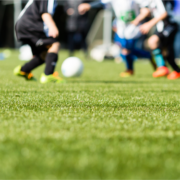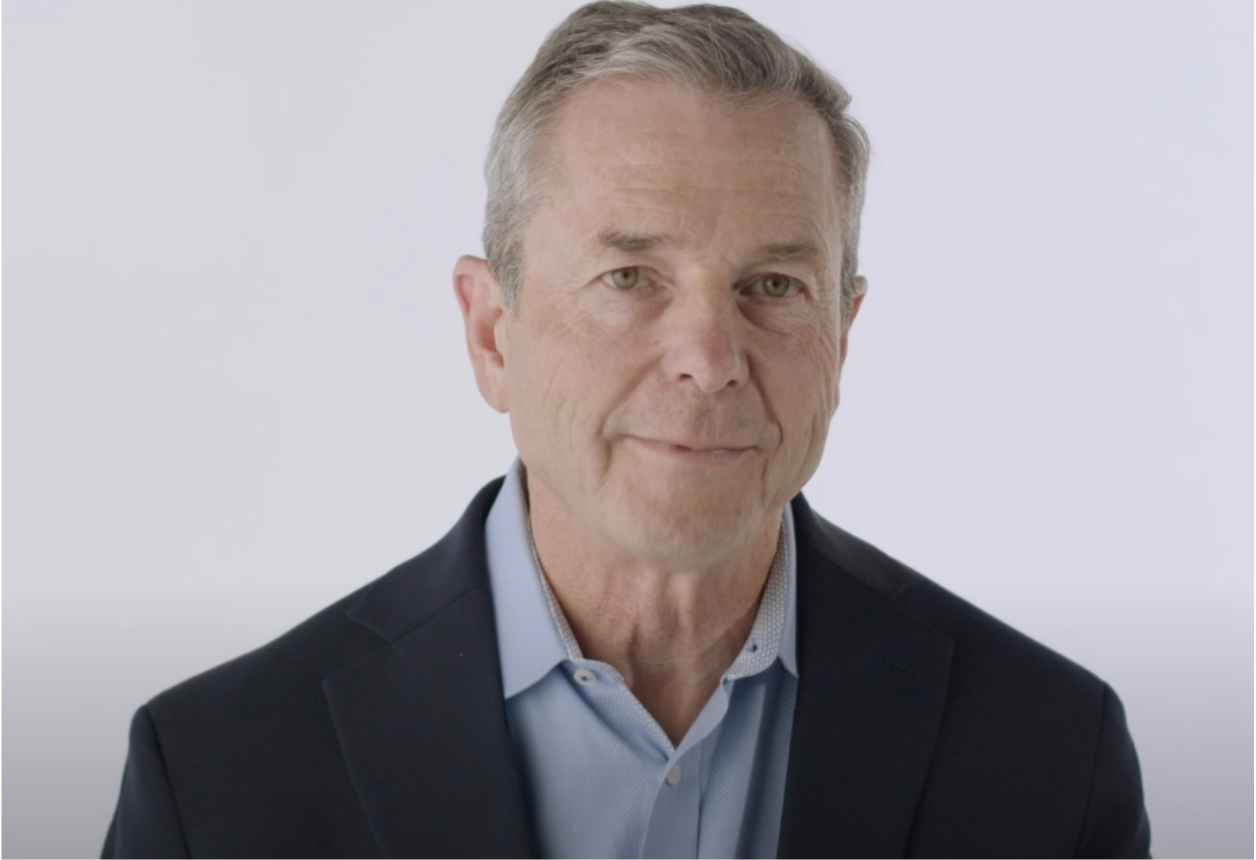 Q: How does your partnership to recycle turf work and what does it mean for the industry?
Q: How does your partnership to recycle turf work and what does it mean for the industry?
We can take a field — any field — at the end of its life for recycling. We remove whatever infill might be in it and then we basically grind that up and pelletize it. We ship it to an advanced recycling facility. They take it to the refinery and they turn it back into plastic products. It’s a USCC-certified circular process, and we’re the first to achieve that. We’re proud and pleased with that partnership.
Q: What’s the environmental impact of that?
Each individual field that we pick up is about 85,000 square feet of turf that does not go into a landfill and that’s a huge number. To date, we’ve processed close to 65 fields. I think another thing to consider though, is the carbon footprint for recycling that field. Recycling existing plastic has a much lower carbon footprint than going out and getting crude oil from the ground and turning it into new plastic. So not only are we recycling fields and keeping them from becoming waste in a landfill, we’re also creating new products in a much more sustainable fashion. We’re really a leader in recycling plastics and that’s just so exciting for me and for the company. We’re making a huge impact for the industry and for plastics as a whole.
Q: There is a history of turf being a solution for play, health and activity for urban areas that didn’t have access to a lot of green space. Do you see it that way still?
Actually, it’s probably much more impactful today. As urban areas grow, you have more people and less land, so it becomes critical to get as much use as you can out of each square inch of green space. Turf allows you to do that.
When you think about trying to maintain grass in an urban environment, it’s even more difficult than a non-urban environment. You have limited sunlight. It’s difficult to get water there. The cost of maintenance is much higher in urban areas, and moving equipment in and out to mow it, to fertilize it — it’s difficult. In major cities like New York and San Francisco, there are hardly any grass fields left because people know the benefit that artificial turf provides. It’s just really difficult to maintain a grass field. And when it’s difficult to maintain, it can become unsafe and it doesn’t get as many hours of play.
And another thing that we don’t talk about that much — it’s in our mission statement to build healthier, more beautiful communities. Artificial turf just always looks good. High school football fields are adding logos and end zones, and they look beautiful all the time, versus mud between the 40-yard lines after the third home game on a natural grass field.
When we put that turf in, the band can practice on it. The JV team can play on it. The freshman team can play on it. They can rent it out on the weekends. It always provides more use, whether it’s an urban environment or a non-urban environment. You get that additional play, and you get a product that stays beautiful, despite so much use.
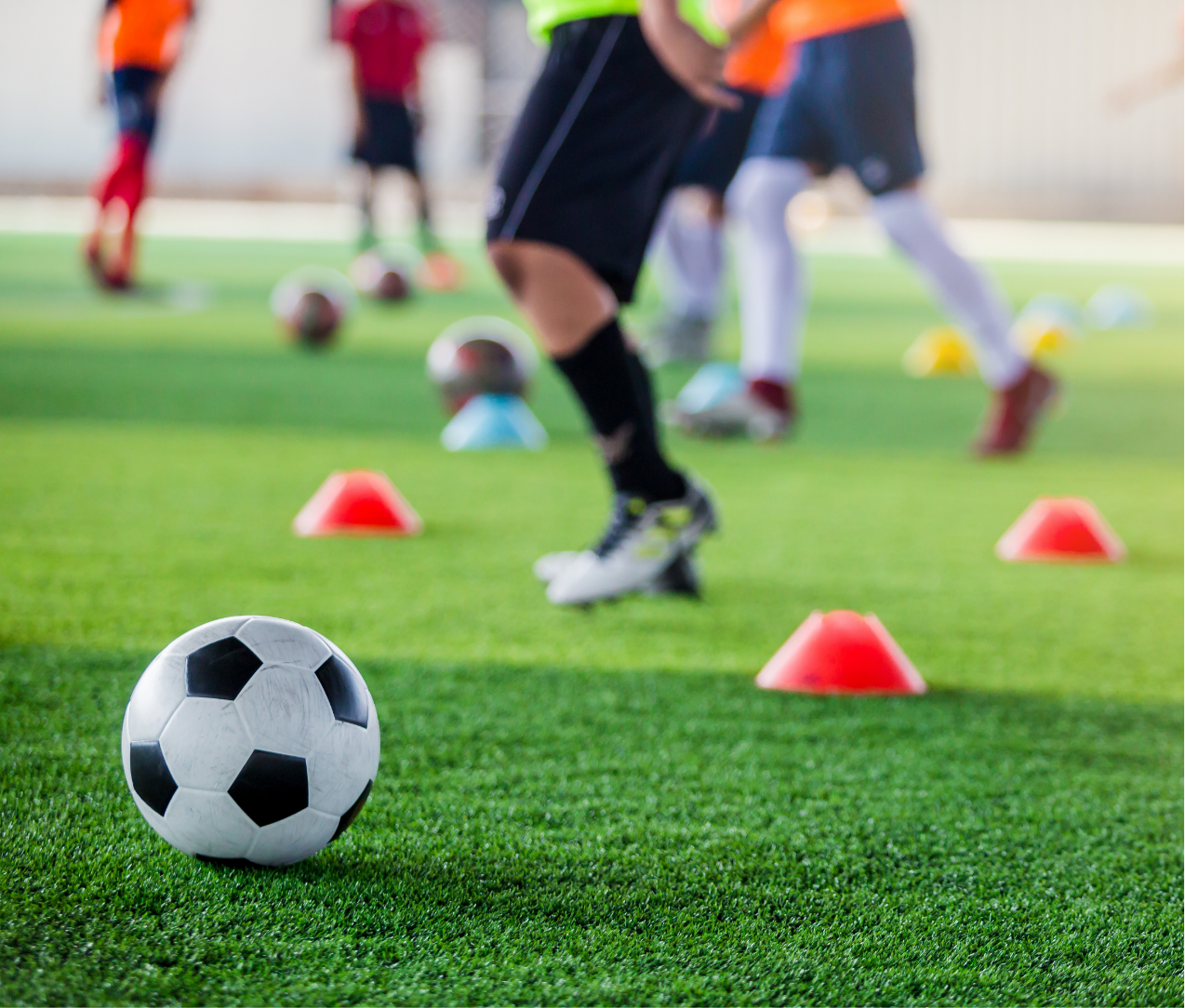 Q: What would you say to those that think that natural grass is the best option, and would never consider artificial turf?
Q: What would you say to those that think that natural grass is the best option, and would never consider artificial turf?
If you think natural grass is the best option, you really ought to do your homework. Get started by talking to athletic directors and Parks and Rec commissioners around the country, because they’re going to tell you the benefits of artificial turf.
These are people that are on their third and fourth generation of artificial turf fields. Because once they go artificial turf, they don’t go back.
- It’s safer because you have a more consistent playing surface.
- It’s cheaper to maintain.
- It provides so many more hours of play, which is becoming more and more critical with constrained budgets for metro areas and schools.
And there are some environmental benefits to turf that are often overlooked, too. Natural grass has some environmental costs.
Q: What are some of those environmental costs?
The environmental costs of maintaining natural grass are actually pretty huge.
First of all, water. Each [natural grass] field takes about an Olympic pool worth of water every year to maintain. With climate change and more regions experiencing drought, that is a cost some communities just can’t afford.
There’s also the constant seeding, fertilizing, all the equipment that runs on gas, and the associated carbon footprint of that maintenance. The EPA guesses that about 5% of pollution from gas-powered motors comes from lawn mowers in the United States. It’s a huge cost from an environmental standpoint in terms of the emissions alone.
Also, fertilizers contain a lot of chemicals. But grass fields require them because most of the grass we use for athletic or leisure fields is not native to this part of the world. So, it requires an awful lot of maintenance to keep that field looking pristine, including processed chemicals like fertilizers.
And that brings up PFAS. There’s a lot of talk about PFAS with artificial turf. And most of that is very erroneous. Natural grass actually has PFAS. You’ll find PFAS in the soil of any natural grass field because fertilizer typically includes PFAS. Some are even categorized as PFAS. Almost all soils in the US have some level of PFAS; it’s just ubiquitous in the environment, which most people don’t realize.
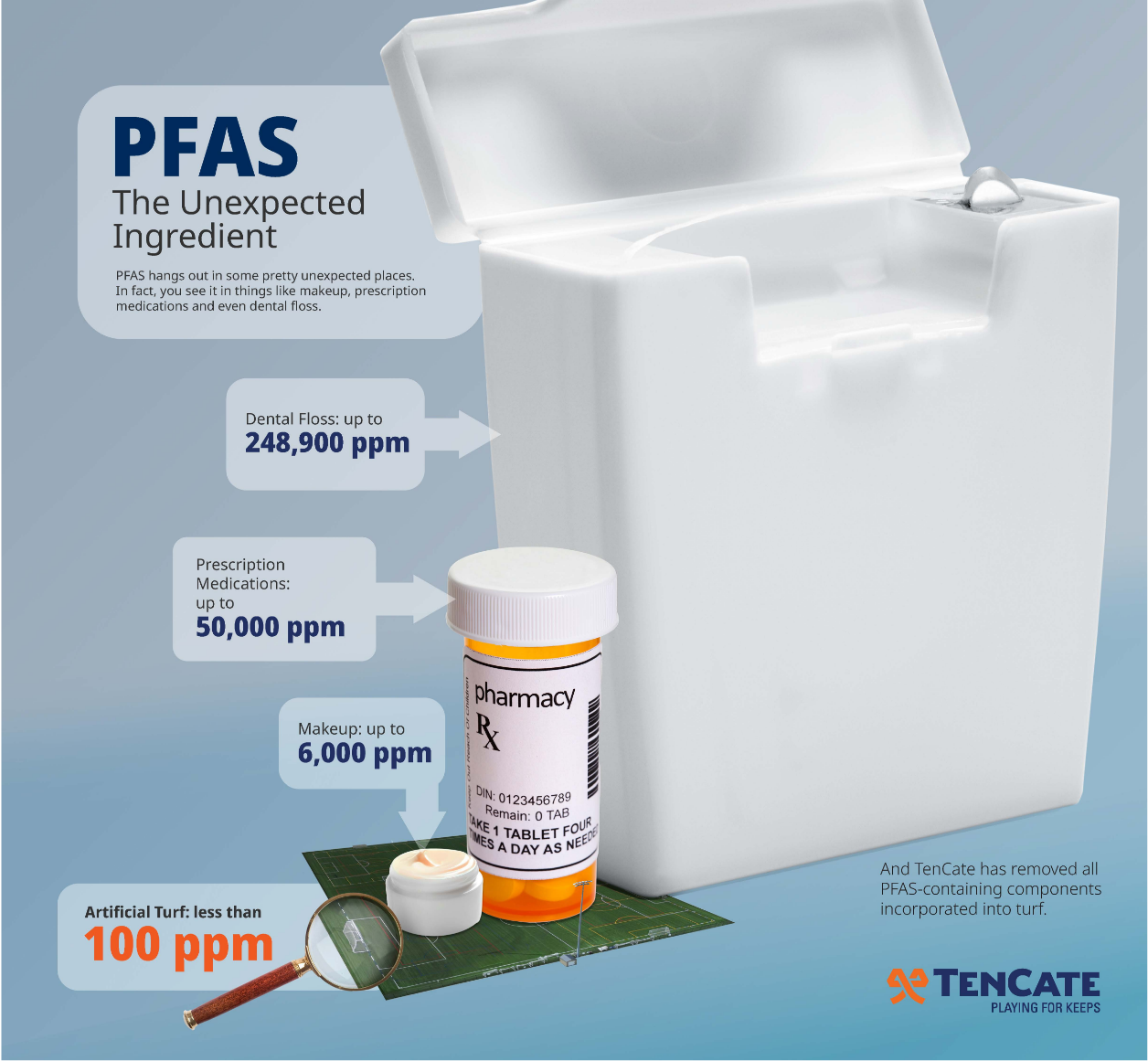 Q: Speaking of PFAS, there are a lot of calls for regional bans on turf because of PFAS content specifically. What are some misconceptions about PFAS and turf we should clear up?
Q: Speaking of PFAS, there are a lot of calls for regional bans on turf because of PFAS content specifically. What are some misconceptions about PFAS and turf we should clear up?
First of all, PFAS is not a component of turf that has anything to do with the performance requirements or the capabilities of the turf. PFAS in turf only comes from an additive, which is basically a lubricant in the extrusion process.
And that is the same for every single type of plastic that you can think of, whether it’s the rayon pants you might be wearing right now, the dental floss that you used this morning or your toothbrush bristles.
All those plastic things are extruded, and all of those require some kind of process aid or lubricant. And that’s what contains PFAS, typically at higher levels than artificial turf. Turf has a lower parts-per-million content of PFAS than your toothbrush, your dental floss or your food wrapper from McDonald’s — all things you put in or near your mouth. So, there’s been some unwarranted hysteria around PFAS in turf, considering we are putting things on or in our bodies that contain far more parts per million of PFAS than the artificial turf beneath your cleats.
Q: Can you tell us more about the bans around artificial turf?
I think a lot of well-intentioned people have concerns about safety and have reached out to their state legislatures saying, “hey, we should just ban turf because it could contain PFAS.” And I can understand wanting to ensure safety for your kids. We all want that!
But it’s born out of misunderstanding, unfortunately due to some erroneous reporting about PFAS in turf. We need to make sure that people understand that existing fields are safe. There are not dangerous levels of PFAS in turf. In fact, the PFAS that are in the turf, according to the Washington Post, cannot be extracted through chemical processes in a lab. That should provide some comfort — knowing that a scientist in a lab can’t extract the 12 parts per million of PFAS out of the turf in a lab setting. So that’s not going to happen naturally. It’s just not going to leach out in the environment or onto the athletes playing on turf.
Most people just want the facts. And when we give them the facts, we’ve seen that concern level in California really come down. But unfortunately, other bills to ban turf have been picked up in a number of other states. We’re seeing legislation in about eight states that have something to do with PFAS. We’re communicating with those legislatures and we’re trying to get the facts out there. And we’re confident that people will make rational decisions when they are armed with facts.
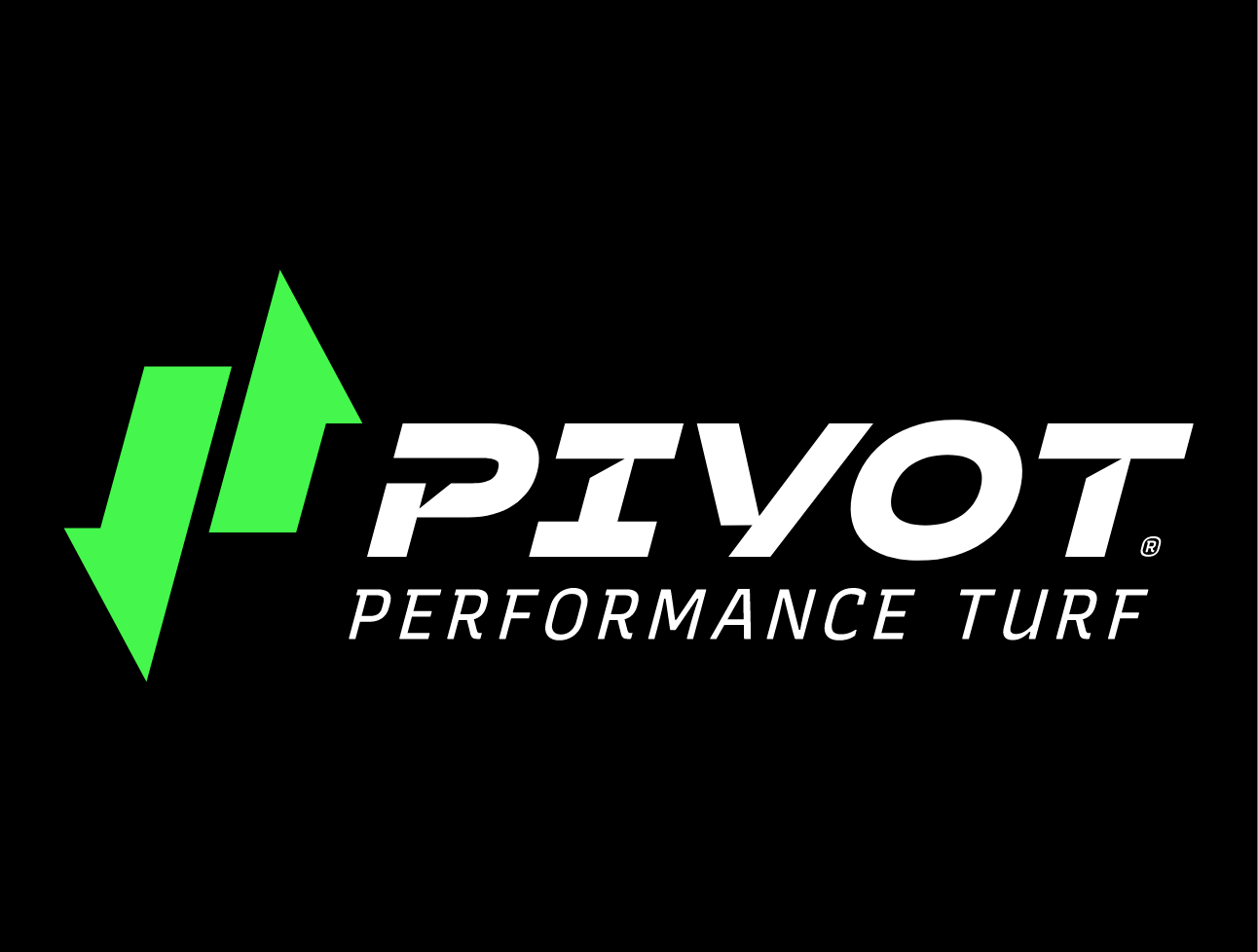 Q: So, you’ve removed PFAS from your design, you’ve initiated recycling partnerships to keep turf from landfills and reuse the materials. This isn’t your grandfather’s turf. What’s next for TenCate?
Q: So, you’ve removed PFAS from your design, you’ve initiated recycling partnerships to keep turf from landfills and reuse the materials. This isn’t your grandfather’s turf. What’s next for TenCate?
Well, you know, we’ve always been the leader in innovation. When we were a company that only made yarn for synthetic turf, we made the best yarn — the most innovative, longest lasting, and sustainable yarn. Over the years, we’ve moved into turf production and the focus was again on sustainability, longevity and safety of play.
And then we migrated into installation of those fields.
So now, as we cover all the components that go into creating and installing a field, we’ve continued to emphasize R&D and innovation. And from that, we’ve developed the most sustainable, safest, most natural grass-like turf in our newest product, Pivot Performance Turf®.
It’s something the industry hasn’t seen before. It’s the culmination of years and years of thinking about sustainability and performance and better play. It’s all of our work on innovation, sustainability and performance coalescing to create just a remarkable, unique product that’s going to be a game changer for the industry.
We can’t wait to get it under people’s feet.
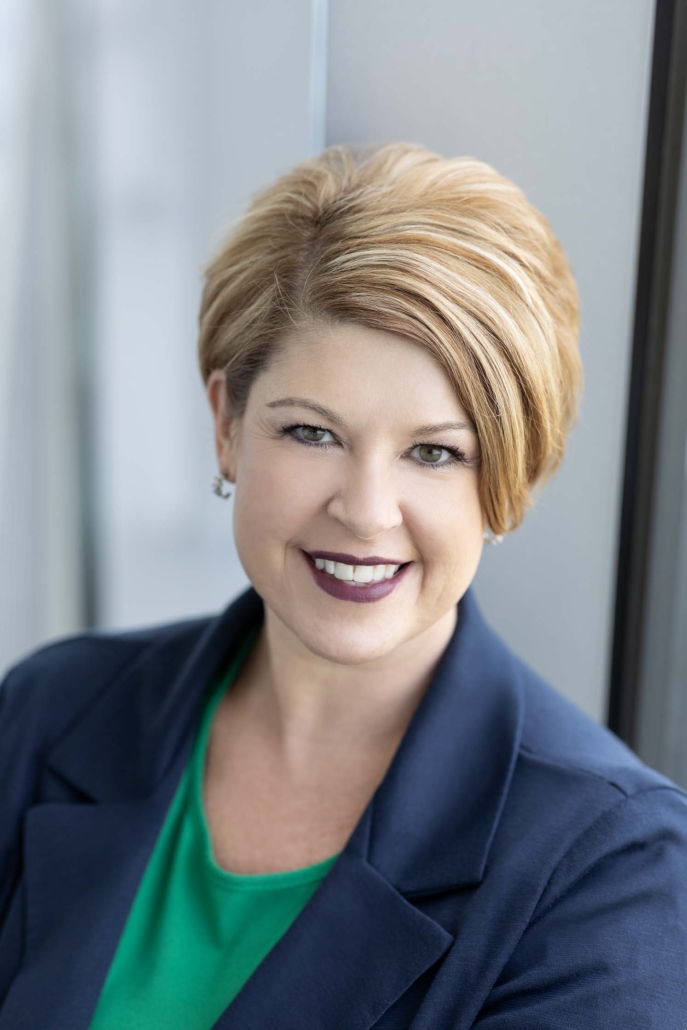 “We are thrilled to add someone with Jessica’s vast communication and leadership experience to our team,” said Joe Fields, President and CEO for TenCate Americas. “Her proven track record of leading both U.S. and global teams in sustainability communications will be invaluable as we continue to expand our sustainability initiatives and achieve our vision of building healthier, more beautiful communities.”
“We are thrilled to add someone with Jessica’s vast communication and leadership experience to our team,” said Joe Fields, President and CEO for TenCate Americas. “Her proven track record of leading both U.S. and global teams in sustainability communications will be invaluable as we continue to expand our sustainability initiatives and achieve our vision of building healthier, more beautiful communities.”

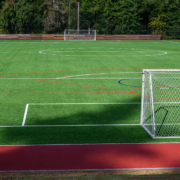
 Q: How does your partnership to recycle turf work and what does it mean for the industry?
Q: How does your partnership to recycle turf work and what does it mean for the industry? Q: What would you say to those that think that natural grass is the best option, and would never consider artificial turf?
Q: What would you say to those that think that natural grass is the best option, and would never consider artificial turf? Q: Speaking of PFAS, there are a lot of calls for regional bans on turf because of PFAS content specifically. What are some misconceptions about PFAS and turf we should clear up?
Q: Speaking of PFAS, there are a lot of calls for regional bans on turf because of PFAS content specifically. What are some misconceptions about PFAS and turf we should clear up? Q: So, you’ve removed PFAS from your design, you’ve initiated recycling partnerships to keep turf from landfills and reuse the materials. This isn’t your grandfather’s turf. What’s next for TenCate?
Q: So, you’ve removed PFAS from your design, you’ve initiated recycling partnerships to keep turf from landfills and reuse the materials. This isn’t your grandfather’s turf. What’s next for TenCate?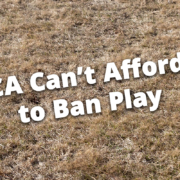
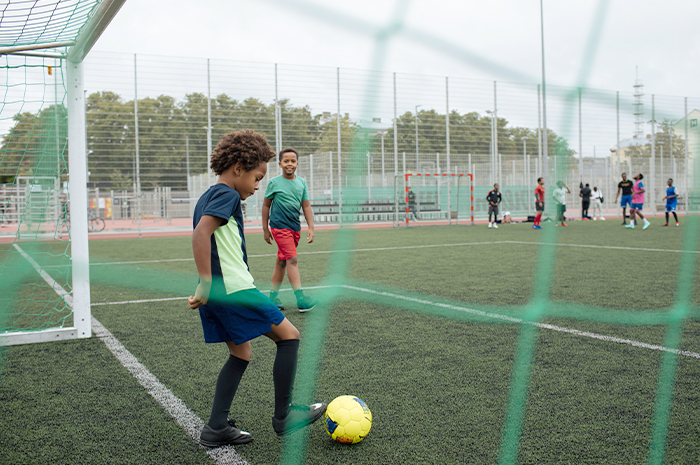
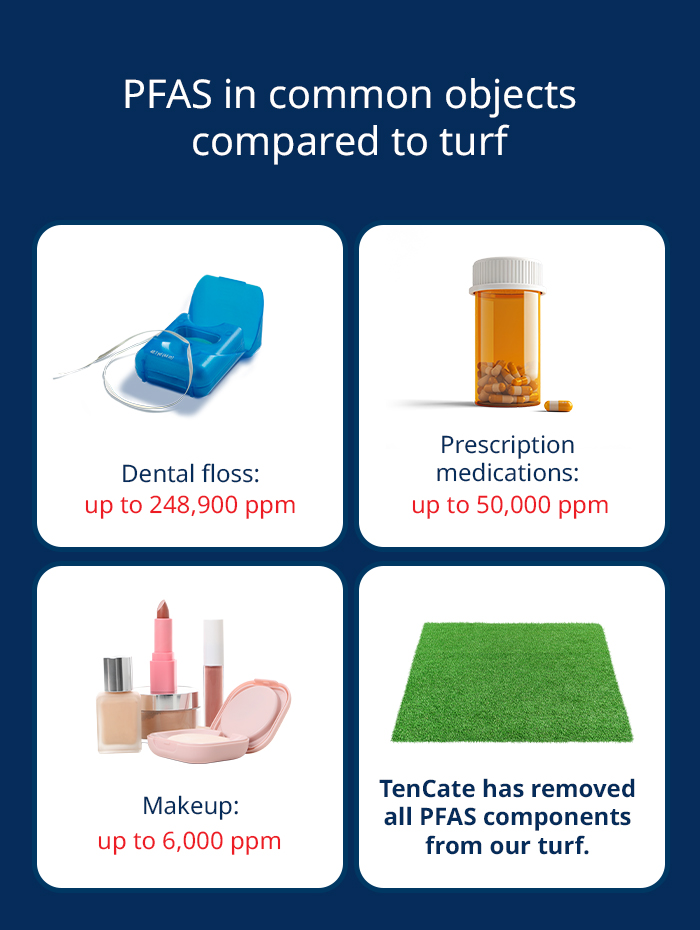
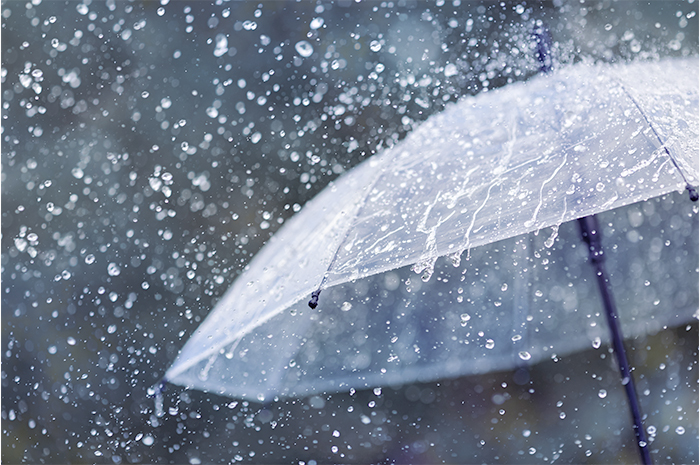
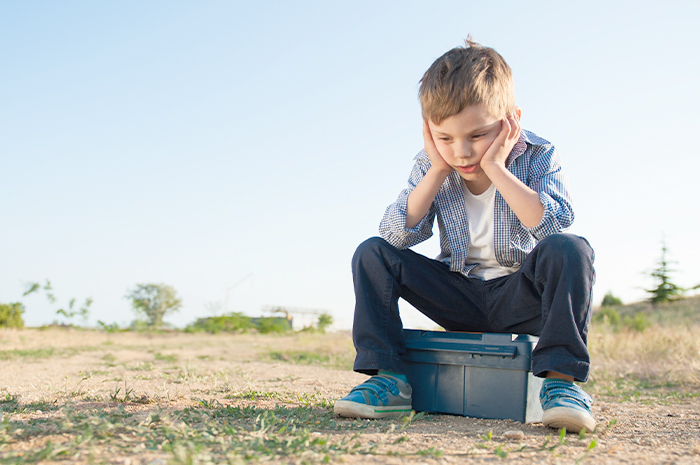
 Alan Reising
Alan Reising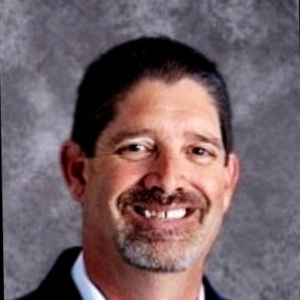 Ted Walstrom
Ted Walstrom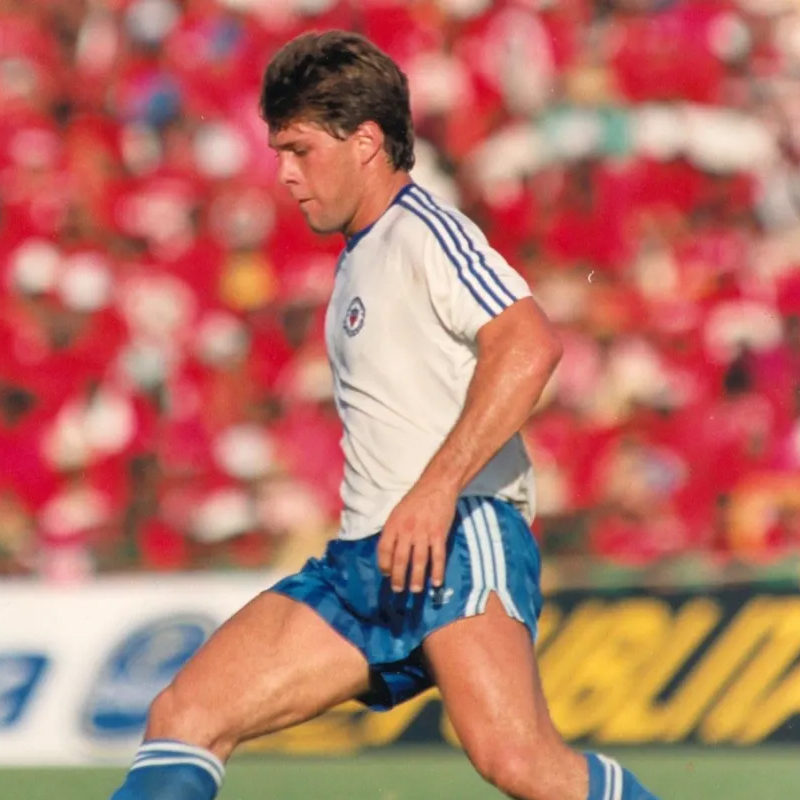 Paul Caliguiri
Paul Caliguiri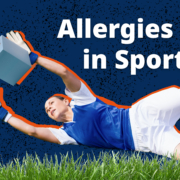
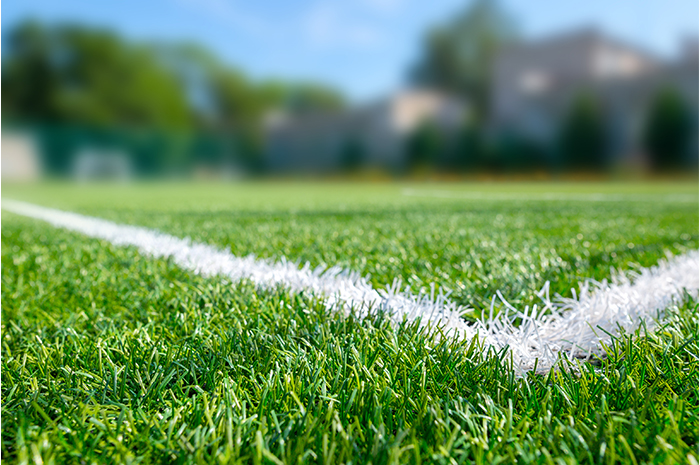 Outdoor Allergies and Sports
Outdoor Allergies and Sports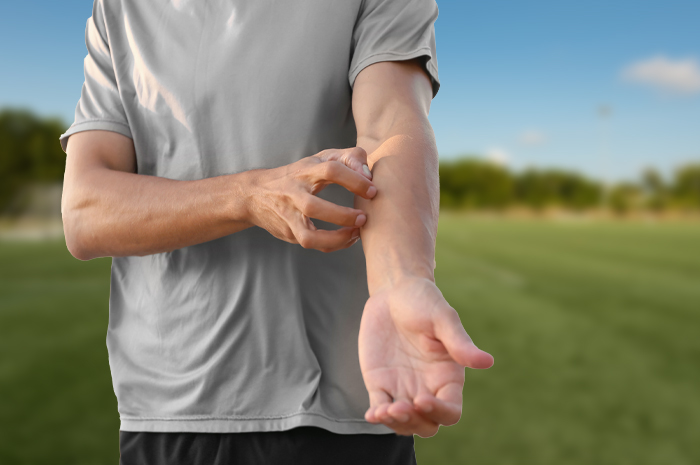 Fescue and Kentucky bluegrass are common grasses known to cause allergies; they also happen to be very popular grasses for sports fields. This means that many sports fields are exposing athletes to conditions that can cause negative reactions, like allergic rhinitis and hay fever. While not as common, for some, exposure to grass can lead to skin irritations, rashes, hives and dermatitis.
Fescue and Kentucky bluegrass are common grasses known to cause allergies; they also happen to be very popular grasses for sports fields. This means that many sports fields are exposing athletes to conditions that can cause negative reactions, like allergic rhinitis and hay fever. While not as common, for some, exposure to grass can lead to skin irritations, rashes, hives and dermatitis.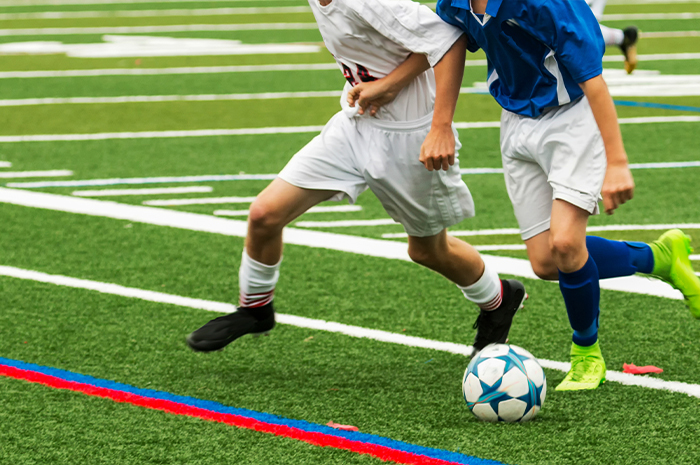
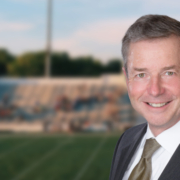


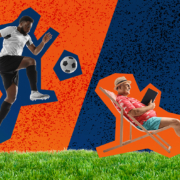
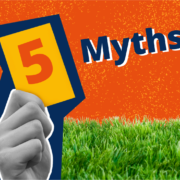
 Myth 1: Turf isn’t safe or good for people.
Myth 1: Turf isn’t safe or good for people.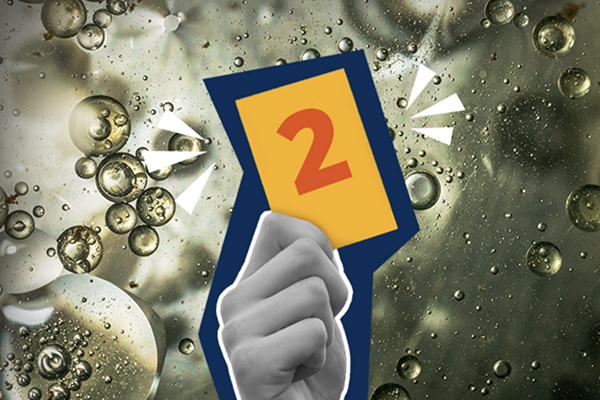 Myth 2: Turf is dangerous because of PFAS exposure.
Myth 2: Turf is dangerous because of PFAS exposure.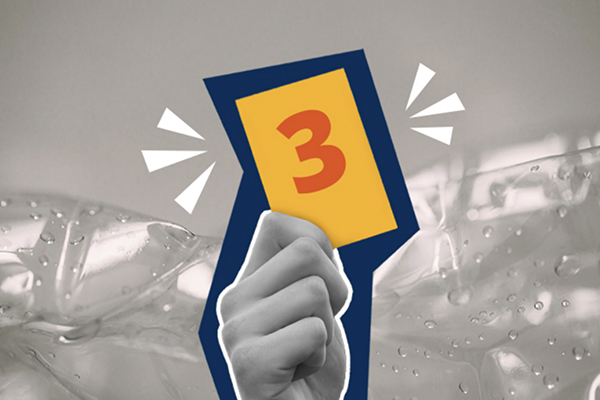 Myth 3: Turf replaces something natural with plastic.
Myth 3: Turf replaces something natural with plastic.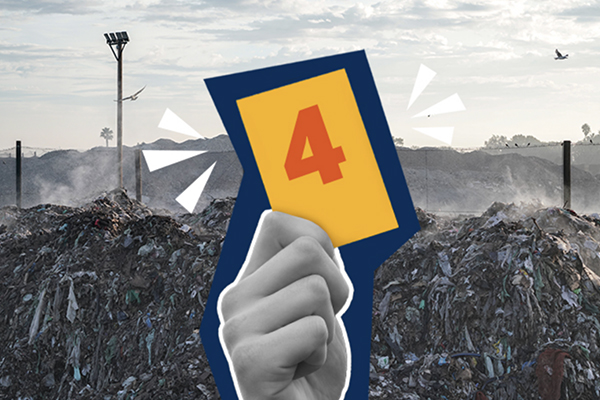 Myth 4: Old turf ends up in a landfill.
Myth 4: Old turf ends up in a landfill. Myth 5: Turf is bad for the environment.
Myth 5: Turf is bad for the environment.